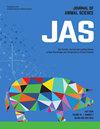164 结合硅学、体外和体内方法研究家猫和家犬的味觉感知和偏好
IF 2.7
2区 农林科学
Q1 AGRICULTURE, DAIRY & ANIMAL SCIENCE
引用次数: 0
摘要
为宠物猫狗开发食品是食品工业中一个重要而又具有挑战性的领域。所提供的饮食必须既均衡又适口,以确保所吃的食物量符合它们的营养需求。宠物的味觉感知在很多情况下与人类不同(Li 等人,2005 年),因此有必要开展针对特定物种的研究。因此,了解猫和狗的口味偏好是一个重要的研究领域,需要多种学科和科学方法。我们已开发出一系列用于研究家猫和家犬味觉感知和偏好的辅助方法 在硅学方面:已开发出宠物味觉受体的同源模型。这些模型用于确定候选化合物,并阐明宠物味觉感知的机制。体外:还开发了基于细胞的宠物味觉受体高通量筛选试验。这些试验用于确定具有味觉活性的化合物,并确认对通过硅学方法确定的化合物的反应,以完善模型。体内:最后,还开发了一种猫双瓶选择测试。该试验用于确认享乐反应,并确定通过硅学和/或体外方法确定的单一化合物和混合物的最佳浓度。利用这种新方法,我们现在对宠物的味觉感知和偏好有了更深入的了解,具体例子包括猫的Umami(McGrane等人,2023年)和Kokumi(Laffitte等人,2021年)味觉感知以及狗的苦味感知(Gibbs等人,2022年)。这种方法还使我们能够通过使用硅学和体外方法优先选择最有前途的味觉剂,从而减少所需的体内试验数量,实现 3Rs 目标。Gibbs, M., Winnig, M., Riva, I., Dunlop, N., Waller, D., Klebansky, B., Logan, D.W., Briddon, S.J., Holliday, N.D., McGrane, S.J. 2022.家犬(Canis familiaris)对苦味的敏感性及其与苦味摄入阻遏剂的相关性。PLoS One.17:e0277607.Laffitte, A., Gibbs, M., Hernangomez de Alvaro, C., Addison, J., Lonsdale, Z.N., Giribaldi, M.G., Rossignoli, A., Vennegeerts, T., Winnig, M., Klebansky, B., Skiles, J., Logan, D.W., McGrane, S.J. 2021.家猫(Felis catus)对Kokumi味觉的感知在食肉动物模型中具有功能性。科学报告 2021 111.11:1-17.Li, X., Li, W., Wang, H., Cao, J., Maehashi, K., Huang, L., Bachmanov, A.A., Reed, D.R., Legrand-Defretin, V., Beauchamp, G.K., Brand, J.G. 2005.猫对糖漠不关心的原因是甜味受体基因的假基因化。PLoS Genet.1:0027-0035.McGrane, S.J., Gibbs, M., Hernangomez De Alvaro, C., Dunlop, N., Winnig, M., Klebansky, B., Waller, D. 2023.家猫(Felis catus)--一种食肉动物--的味觉感知和偏好。化学感官。48.本文章由计算机程序翻译,如有差异,请以英文原文为准。
164 Combining in silico, in vitro, and in vivo approaches for studying taste perception and preferences of domestic cats and dogs
Developing food products for pet cats and dogs is an important and challenging area of the food industry. The diet offered must be both balanced and palatable to ensure the amount of food eaten meets their nutritional requirements. The taste perception of pets is different from humans in many cases (Li et al., 2005) and therefore species-specific research is necessary. Hence, understanding the flavor preferences of cats and dogs is an important area of research and requires multiple disciplines and scientific approaches. We have developed a range of complimentary methods for studying taste perception and preferences of domestic cats and dogs In silico: homology models of the pet taste receptors have been developed. These models are used to identify candidate compounds and elucidate the mechanisms of taste perception of pets. In vitro: cell-based high throughput screening assays of pet taste receptors have also been developed. These assays are used to identify taste-active compounds and confirm response to those identified via the in silico method to refine the model. In vivo: finally, a two-bottle choice test for cats has been developed. This test is used to confirm hedonic responses and determine optimum concentrations of single compounds and mixtures identified by the in silico and/or in vitro methods. Using this novel approach, we now have a deeper understanding of the taste perception and preferences of pets, with specific examples including Umami (McGrane et al., 2023) and Kokumi (Laffitte et al., 2021) taste perception of cats and bitter taste perception of dogs (Gibbs et al., 2022). This approach has also enabled us to reduce the number of in vivo tests required, so implementing the 3Rs, by prioritizing the most promising tastants using the in silico and in vitro methods. Gibbs, M., Winnig, M., Riva, I., Dunlop, N., Waller, D., Klebansky, B., Logan, D.W., Briddon, S.J., Holliday, N.D., McGrane, S.J. 2022. Bitter taste sensitivity in domestic dogs (Canis familiaris) and its relevance to bitter deterrents of ingestion. PLoS One. 17:e0277607. Laffitte, A., Gibbs, M., Hernangomez de Alvaro, C., Addison, J., Lonsdale, Z.N., Giribaldi, M.G., Rossignoli, A., Vennegeerts, T., Winnig, M., Klebansky, B., Skiles, J., Logan, D.W., McGrane, S.J. 2021. Kokumi taste perception is functional in a model carnivore, the domestic cat (Felis catus). Sci Reports 2021 111. 11:1–17. Li, X., Li, W., Wang, H., Cao, J., Maehashi, K., Huang, L., Bachmanov, A.A., Reed, D.R., Legrand-Defretin, V., Beauchamp, G.K., Brand, J.G. 2005. Pseudogenization of a sweet-receptor gene accounts for cats’ indifference toward sugar. PLoS Genet. 1:0027–0035.McGrane, S.J., Gibbs, M., Hernangomez De Alvaro, C., Dunlop, N., Winnig, M., Klebansky, B., Waller, D. 2023. Umami taste perception and preferences of the domestic cat (Felis catus), an obligate carnivore. Chem Senses. 48.
求助全文
通过发布文献求助,成功后即可免费获取论文全文。
去求助
来源期刊

Journal of animal science
农林科学-奶制品与动物科学
CiteScore
4.80
自引率
12.10%
发文量
1589
审稿时长
3 months
期刊介绍:
The Journal of Animal Science (JAS) is the premier journal for animal science and serves as the leading source of new knowledge and perspective in this area. JAS publishes more than 500 fully reviewed research articles, invited reviews, technical notes, and letters to the editor each year.
Articles published in JAS encompass a broad range of research topics in animal production and fundamental aspects of genetics, nutrition, physiology, and preparation and utilization of animal products. Articles typically report research with beef cattle, companion animals, goats, horses, pigs, and sheep; however, studies involving other farm animals, aquatic and wildlife species, and laboratory animal species that address fundamental questions related to livestock and companion animal biology will be considered for publication.
 求助内容:
求助内容: 应助结果提醒方式:
应助结果提醒方式:


